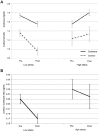Low-stress and high-stress singing have contrasting effects on glucocorticoid response
- PMID: 26388794
- PMCID: PMC4559645
- DOI: 10.3389/fpsyg.2015.01242
Low-stress and high-stress singing have contrasting effects on glucocorticoid response
Abstract
Performing music in public is widely recognized as a potentially stress-inducing activity. However, despite the interest in music performance as an acute psychosocial stressor, there has been relatively little research on the effects of public performance on the endocrine system. This study examined the impact of singing in a low-stress performance situation and a high-stress live concert on levels of glucocorticoids (cortisol and cortisone) in 15 professional singers. The results showed a significant decrease in both cortisol and cortisone across the low-stress condition, suggesting that singing in itself is a stress-reducing (and possibly health-promoting) activity, but significant increases across the high-stress condition. This is the first study to demonstrate that singing affects cortisol as well as cortisone responses and that these responses are modulated by the conditions of performance.
Keywords: cortisol; glucocorticoids; music; performance science; singing; stress.
Figures


References
-
- Abel J. L., Larkin K. T. (1990). Anticipation of performance among musicians: physiological arousal, confidence, and state-anxiety. Psychol. Music 18, 171–182. 10.1177/0305735690182006 - DOI
-
- Beck R., Cesario T. C., Yousefi A., Enamoto H. (2000). Choral singing, performance perception, and immune system changes in salivary immunoglobulin a and cortisol. Music Percept. 18, 87–106. 10.2307/40285902 - DOI
-
- Brotons M. (1994). Effects of performing conditions on music performance anxiety and performance quality. J. Music Ther. 31, 63–81. 10.1093/jmt/31.1.63 - DOI
-
- Brugués A. O. (2011). Music performance anxiety–part 1. A review of its epidemiology. Med. Probl. Perform. Art. 26, 102–105. - PubMed
LinkOut - more resources
Full Text Sources
Other Literature Sources

